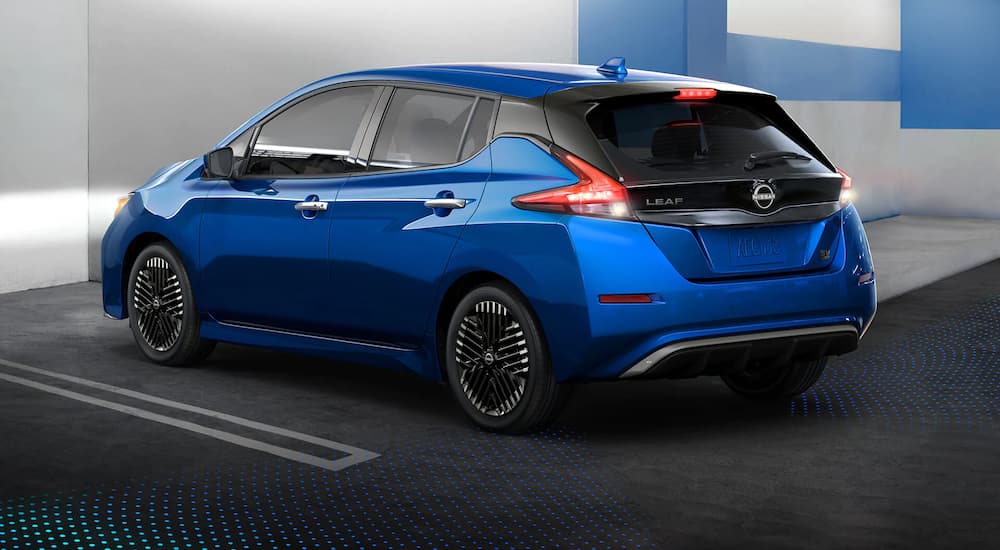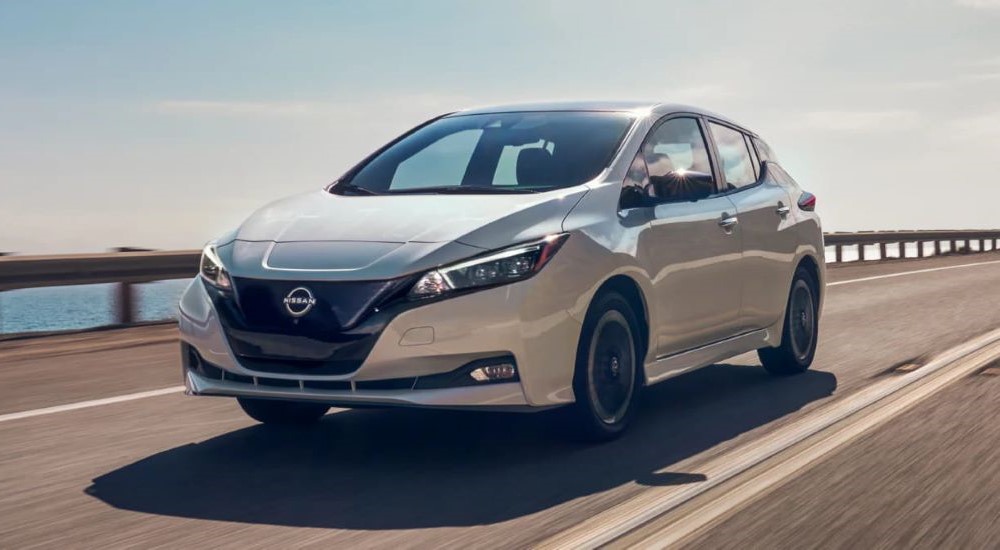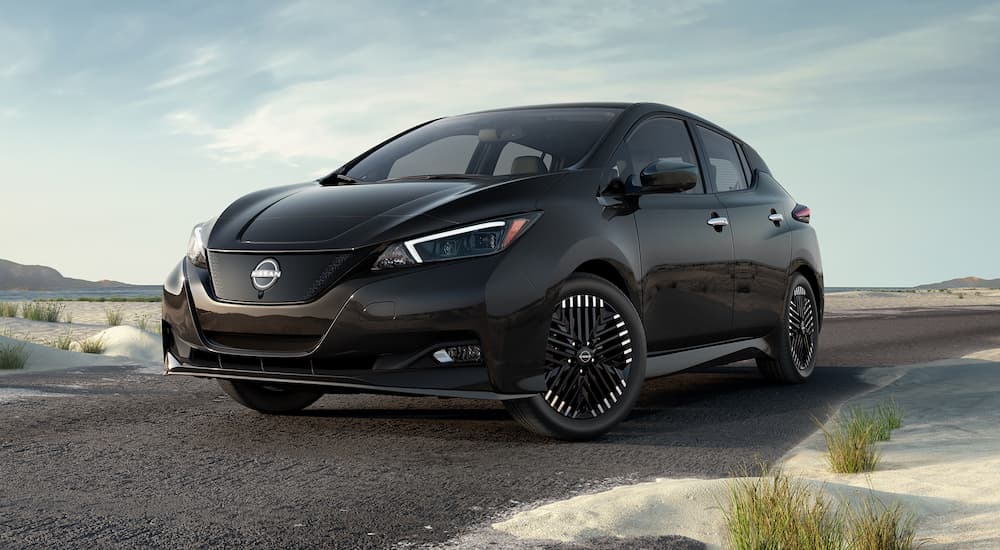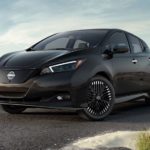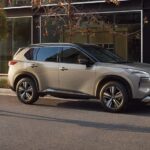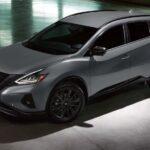The 2023 LEAF marked a redesign for Nissan’s electric hatchback. It’s been in production for 13 years, making it one of the most notable and longest-running EVs currently available on the market. This is significant because it means that Nissan has had a lot of time to refine and modify the design of the LEAF to become ever-more viable for the consumer market and those looking for a reliable and unique EV. Over the course of the two generations of the LEAF, the engineers have taken time to introduce new features and update existing content to make prospective shoppers consider a Nissan LEAF for sale as opposed to shopping for something from the competition.
What makes the 2023 LEAF worthwhile? Why would shoppers who are considering an EV––or even a compact hatchback in general––look at the LEAF? Well, there are some new features that not only help make the vehicle seem more worthwhile for shoppers but also hint at the importance of the future of Nissan’s endeavours in the alternative-fuel segment. But what are these features, and why do they matter in the larger scheme of things?
The Updated Front Fascia Adds to the LEAF’s Appeal
There’s a minor exterior buff to the 2023 LEAF. It’s not the first time the front fascia has been updated, nor will it be the last. The last major overhaul for the LEAF came with the introduction of the second generation for the 2018 model year. This change was a massive overhaul from the outgoing first generation. An all-new grille, hood design, headlight array, and diffuser gave the second-generation LEAF a more sporty and modern look.
The updated exterior for the 2023 model year involved less extensive but still significant changes. The front fascia has seen a refresh in the form of a blacked-out grille with a black surround and a slightly updated bumper. Additionally, the centre Nissan logo has been altered with an updated illuminated badge, which is a nice little touch. There are also the new five-spoke 43 cm aluminum alloy sports wheels, which help give the LEAF a more modern look.
Why does this front fascia refresh matter for the 2023 LEAF? Well, it points towards the future of the LEAF and where Nissan wants to go with its design. You see, it has a more aggressively modern look that feeds into its all-electric architecture, all while maintaining an aerodynamic look. The chrome trim for Nissan’s V-Motion grille has been completely removed for a blacked-out visage, and it gives the impression of what we might be able to expect from future models of the LEAF. Perhaps a bolder and sportier design to feed into a potential hot-hatch variant? No matter what comes, added visual appeal for an EV is never a bad thing, and it’s good to see Nissan embracing these changes as we move further into the second generation of the Nissan LEAF.
Updated Interior Badging and Infotainment Start-Up
The digital driver display and the steering wheel for the 2023 Nissan LEAF have also been updated with some unique quality-of-life alterations. The Nissan badge has been added to the centre of the LEAF’s steering wheel, and the logo has also been added as part of the start-up display. In the case of the steering wheel, you have a bold Nissan badge, and in the case of the digital driver display on the dashboard in front of the driver, the start-up shows the logo.
Why is this important? Well, it’s all part of the new branding for Nissan and utilizing that badging to improve the overall presence of the company within the vehicle. This is something that Nissan will be doing more aggressively moving forward, which will likely play a bigger role in future models, especially alternative fuel vehicles. Separating from the competition by having a unique design language and prominent logos makes it easier to impress both the driver and potential buyers.
Raising the prominence and value of the Nissan brand for future EVs and giving more identity to the LEAF means the company is rolling out serious plans for the future. This may not seem all that important right now, but it’s more about laying the foundations, which could prove to be vital for Nissan’s endeavours with alternative fuel vehicles. It could also open up a more aggressively stylized LEAF that embodies more uniquely flavoured Nissan design cues.
New Trim Lineup Compacts More Features in Fewer Trims
Automakers often attempt to avoid discussing trim selections when the trim options have been narrowed down, or certain extraneous trims have been removed from the lineup. In some ways, marketing departments see it as advertising less to potential customers. However, having fewer trims isn’t always a bad thing. Sometimes, companies have to squeeze features from the removed trims into the existing trims, and that’s what Nissan has done for the 2023 model year.
If you were shopping for a 2023 Nissan LEAF and noticed that the trim offerings looked different, it’s because they are different. The outgoing 2022 model had four trims, which included the SV, S PLUS, SV PLUS, and SL PLUS. The new 2023 LEAF now only has three trims: the SV, SV PLUS, and SL PLUS. You might notice that the S PLUS has been removed from the lineup. However, losing the base trim hasn’t eliminated any features.
The 2023 LEAF includes improved gloss black details to go with the black cloth interior of the SV and SV PLUS, and you can upgrade to leather upholstery in the SL PLUS. While some people might see three trims as getting fewer options, the SV now has more features, which is a good thing. It means you get more out of the base trim and more standard features across the rest of the trim lineup. As long as Nissan keeps expanding on the trim features rather than the trim list, it’s all good as far as most people are concerned.
Battery Charge Times and Warranties
While the battery packs haven’t changed for the 2023 Nissan LEAF, the battery pack options and charge times are still important features of the model year. Why? Because compared to some of the other EVs on the market, the Nissan LEAF has very short charge times. How short? Well, if you have the base 40 kWh battery, you can use a Level 2 charger to charge the battery to full in about eight hours. That’s not bad at all, given how easy Level 2 chargers are to install at home. You could begin charging the LEAF at night after you get home from work, and it would be ready and fully charged the next day.
The optional 62 kWh battery pack takes approximately 11.5 hours to fully recharge with a Level 2 charger. That’s quite impressive because even if you fully empty the battery, you will have a 100% charge when you set off in the morning after charging overnight. Even more impressive is that you can recharge to 80% at a Level 3 DC Fast Charge station in just 45 minutes. That’s perfect when it comes to getting you back on the road, which is one of the most advantageous features for an EV.
To top everything off, the 2023 Nissan LEAF comes with a lithium-ion battery pack warranty. It covers any defects for eight years or 160,000 km, which is quite comforting for drivers who are a little cautious about buying an EV. It’s a warranty that certainly encourages confidence. The warranty also covers battery pack degradation or capacity loss, another factor that reinforces dependability, as it means that if you’re losing charge or unable to charge fully, Nissan will cover the work necessary to replace the battery pack. While some people may not see warranties as being alluring, it’s actually the sort of thing that inspires confidence in shoppers.
Consistent Improvements and New Opportunities
As Nissan continues refining and improving the LEAF, the brand adds more value to this already compelling model. Features like additional security in the form of extended powertrain warranties only enhance its overall value, while consistent improvements to the car’s performance and charging give it much more versatility for potential shoppers looking for an alternative fuel vehicle. But what do you think of the 2023 Nissan LEAF? Do you like the changes? How do you feel about the improvements and the upgrades? What would you consider to be its top features, and why do they matter to you?
